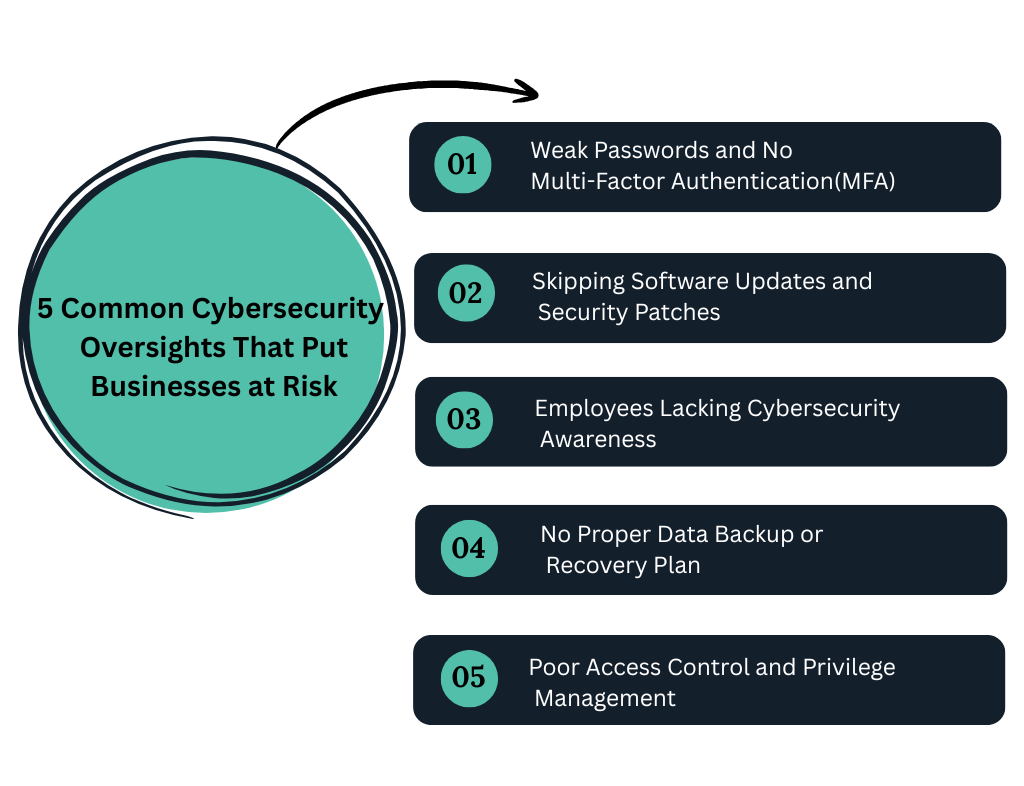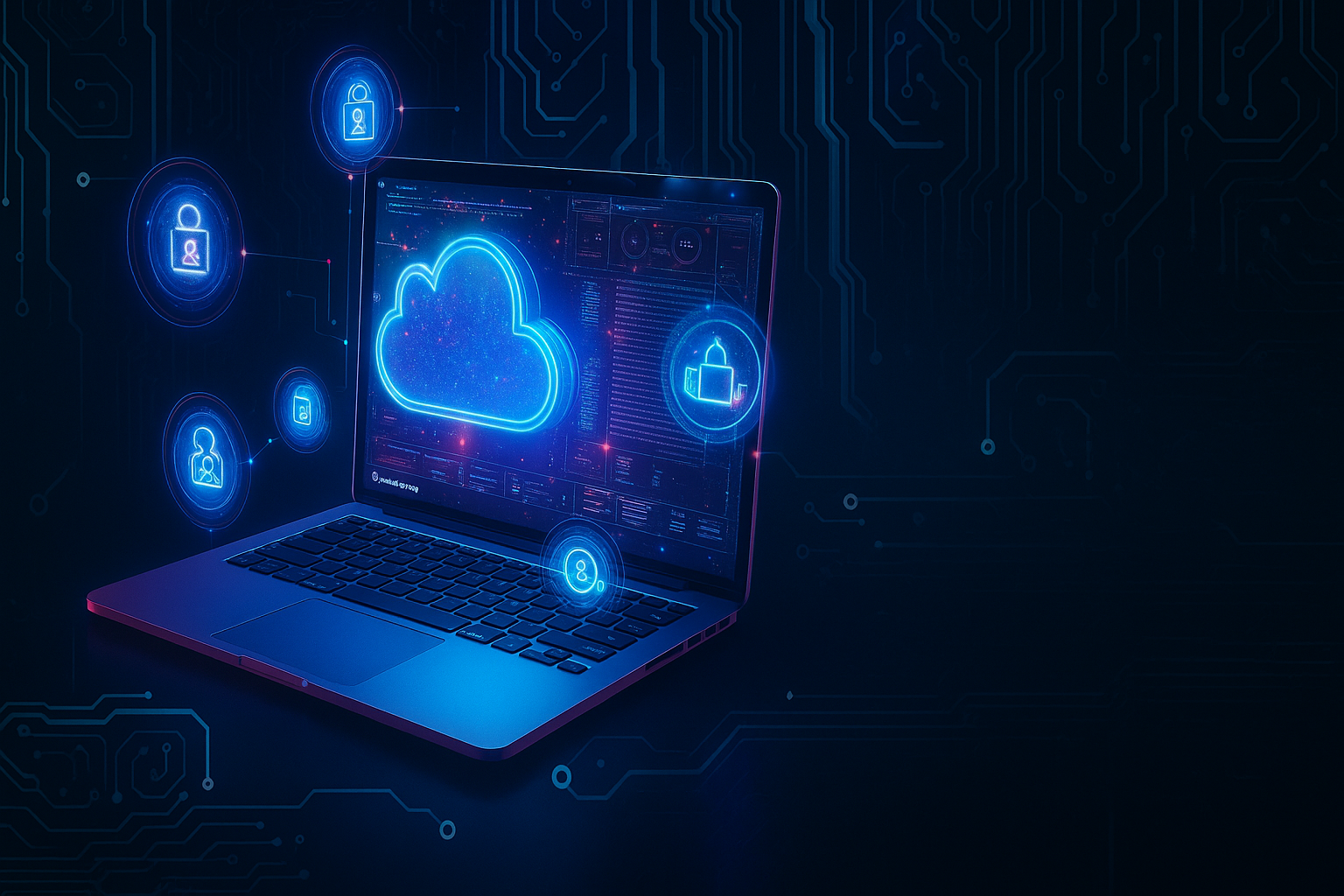In today’s fast-paced digital world, every business regardless of size & faces cybersecurity threats.Many organizations still overlook simple precautions that could prevent devastating attacks. From weak passwords to poor access management, these small oversights can have massive consequences.
You can read also: Cybersecurity in 2025: Protecting Businesses from Evolving Threats
Here are five common cybersecurity mistakes businesses make and why fixing them is essential to protect your operations, reputation, and customer trust.

Weak Passwords and No Multi-Factor Authentication (MFA)
Passwords are often the first line of defense, but they’re also one of the weakest points in cybersecurity. Many employees reuse passwords or choose simple combinations that are easy to guess. Without multi-factor authentication (MFA), a single stolen password can give cybercriminals full access to critical systems.
Stronger password practices and authentication layers can dramatically reduce the chances of unauthorized access and data theft.
Skipping Software Updates and Security Patches
When businesses delay or ignore software updates, they leave doors open for attackers. Updates often include fixes for known vulnerabilities that hackers actively exploit. Even a small delay in patching systems can expose your business to malware or ransomware.
Keeping software current ,from operating systems to apps and firewalls, is one of the simplest and most effective ways to maintain strong cybersecurity.
Employees Lacking Cybersecurity Awareness
Human error remains one of the leading causes of data breaches. Untrained employees might fall for phishing emails, click on links, or mishandle sensitive data. Without awareness, even the best security tools can’t prevent internal mistakes.
Regular cybersecurity training empowers your team to recognize threats and respond effectively. When employees understand the risks, they become your strongest line of defense.
No Proper Data Backup or Recovery Plan
Data is the lifeblood of any organization, many businesses lack a solid backup and recovery plan. If ransomware strikes or system crash, the absence of reliable backups can lead to permanent data loss and operational downtime.
Consistent, automated, and secure backups help ensure your business can recover quickly after an incident. It’s not just about prevention , it’s about being prepared for the unexpected.
Poor Access Control and Privilege Management
Too often, employees are granted more access than necessary. This increases the risk of data leaks, insider threats, and accidental mishandling of sensitive information.
Implementing role-based access and reviewing permissions regularly helps safeguard data. Limiting access to only what’s needed keeps your systems more secure.
How to Fix it
Fixing these cybersecurity gaps doesn’t require a huge budget , just consistency and awareness. Start by enforcing strong, unique passwords and enabling multi-factor authentication (MFA) on all important accounts to block unauthorized access.
Keep all software and security tools updated by turning on automatic updates and applying patches right away. Regular cybersecurity training also helps employees spot phishing attempts and avoid risky actions that could expose your systems.
Create a solid data backup and recovery plan following the 3-2-1 rule — three copies of data, two types of storage, and one off-site backup. Lastly, limit data access to only those who need it and review permissions often.
These simple steps together form a strong, layered defense that keeps your business secure and ready to face evolving digital threats.
Conclusion
Cybersecurity failures often stem from simple oversights, not sophisticated attacks. Weak passwords, skipped updates, unaware employees, poor backups, and loose access control may seem minor, but together they create serious vulnerabilities.
By addressing these issues early, businesses can reduce risks, avoid costly breaches, and maintain customer trust. Cybersecurity isn’t a one-time setup,it’s an ongoing commitment to vigilance, awareness, and protection.
FAQ’s
1. Why is cybersecurity important for small and medium businesses?
Cybercriminals often target small and mid-sized businesses because they typically have weaker defenses. A single breach can lead to data loss, financial damage, and reputational harm.
2. How can I strengthen password security for my team?
Encourage the use of complex, unique passwords and enable multi-factor authentication across all business accounts. Password managers can help employees create and store strong credentials securely.
3. What’s the best way to keep software up-to-date?
Enable automatic updates wherever possible and schedule regular system maintenance. Keeping software current ensures protection against known vulnerabilities.
4. How does employee cybersecurity training help?
Training reduces human error by teaching employees how to identify phishing attempts, handle sensitive data, and follow safe online practices. Informed employees act as your first defense line.
5. What should be included in a data backup strategy?
A good backup plan includes frequent automated backups, secure offsite storage like cloud systems, and regular testing to confirm that files can be restored quickly if needed.

